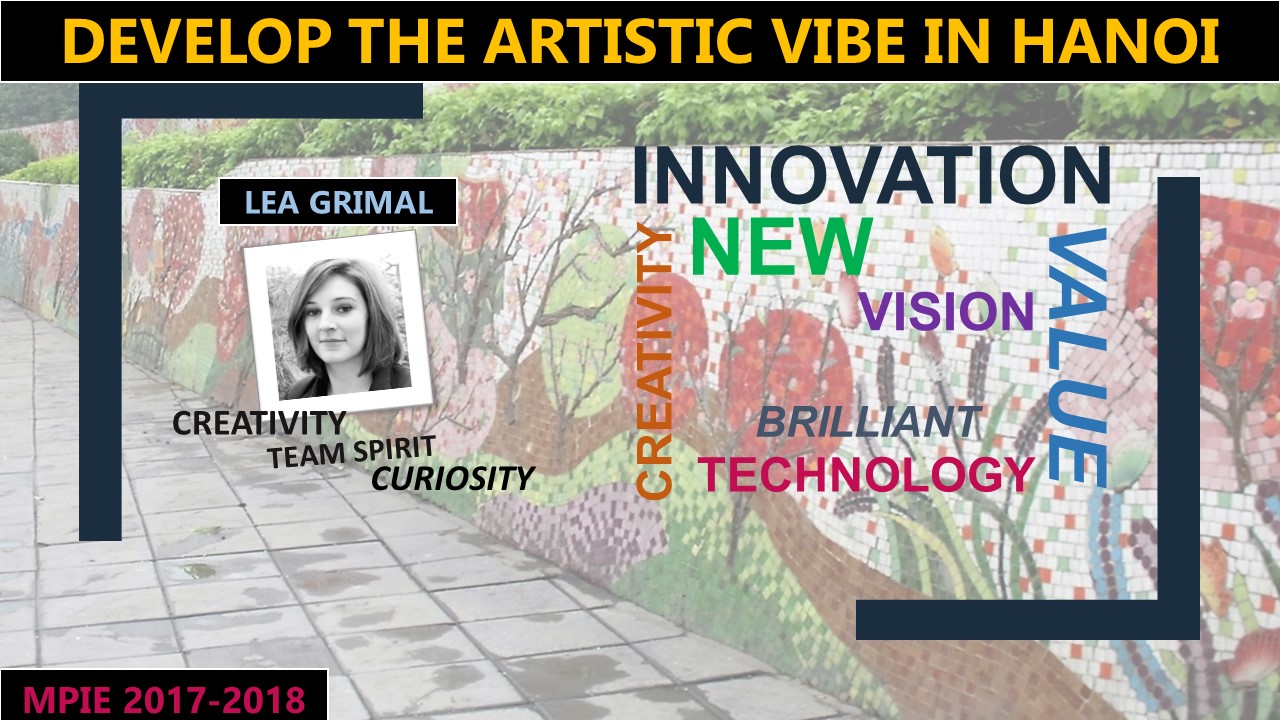Author Archives: Lea GRIMAL
tremendous ambition – FIREFLY – Léa Grimal
Technopark
Technopark – Definition
In Hanoï, a technopark is an integrated area that combines the industries, universities, research centers, entrepreneurship, banking, central and local government in a location that allows the flow of information and technology more efficiently and quickly.
Hoa Lac high-tech zone in Hanoï
Hoa Lac High-tech zone is a place to attract investors in the research and development field, training and incubation, manufacturing high tech product in the fields:
- Biotechnology
- Information
- Communication technology
This place is very attractive for his location, the high quality of human resources and the modern infrastructures.
Example of some stakeholders in Hoa Lac high-tech zone:
- Vietnamese National Bank : Print money
- Ventures : ODA investment
- Science and technology academy (Vietnam/Korea)
- Vietnam/Japan university
- Hanoi national university
- Pharmaceutical factory of CVI company GMP
- Government : strong support -> no taxes for the companies here
- Pharmaceutical R&D
Interview :
We met Mr Huu, a team member of CVI Pharmaceutical Project in Hoa Lac high-tech zone.
What is your project in Hoa Lac high-tech zone?
In Hoa Lac high-tech zone, CVI Pharmaceutical industry is investing in pharmaceutical factory to produce herbal medicines and functional food.
How much does it cost?
They invested 31 million VND.
How this technopark is linked to innovation?
In this place, we can find many factories, R&D research center, universities and bank in one place. As a pharmaceutical industry, they order very often R&D from university, so it is a big advantage to be in this high-tech zone because all the stakeholders are very close. And more, there is support from the government. Working in this zone develop their company and their brand.
Link of the video : https://www.youtube.com/watch?v=hyO64FYWd9o
Huu and Léa.
Team spirit – Léa GRIMAL

Practice knowledge creation to enhance innovation!
In this article, the authors tried to explore the link between innovation, knowledge creation and the firm’s performance in emerging countries. This study was conducted on 529 Vietnamese firms, and the authors tried to answer to two main questions:
- Do knowledge creation practices lead to firm innovation?
- What are the relationships between knowledge creation practices, innovation and firm financial performance?
In order to measure this links, the authors used SECI model (Nonaka’s theory) for the knowledge creation process. Following this model, knowledge is classified in two groups: tacit knowledge (intuitive and unclear) and explicit knowledge (can be expressed with words, numbers). The SECI model is about the dialogue between this two kind of knowledge, and four modes of conversation are identified: socialization (tacit to tacit), externalization (tacit to explicit), combination (explicit to explicit) and internalization (explicit to tacit). The measure of innovation is axed around four main kind of innovation: Product/Process/Organizational/Marketing. Then, they measured the firm’s performance through ROA (return on asset) and average staff’s earning.
The results show a correlation between the practice of knowledge creation and product innovation, organizational innovation and marketing innovation. Also, this study show that only product innovation have a positive impact on the firm’s performance. There is not significant link between firm’s performance and marketing innovation, process innovation and organizational innovation. The practice of knowledge creation does not directly influence the firm’s performance, but when knowledge creation is used to create product innovation, it has a positive impact on the firm’s performance.
Source : Thang Nguyen, Thi Thuc Anh Phan, Mai Thi Tuyet Nguyen International Journal of Business and Management – May 2016. Knowledge Creation, Innovation and Financial Performance of Firms: Evidence from Vietnam.
As a part of the MPIE master, we went to some places where normally, knowledge creation is the core activity: coworking spaces. Coworking is a style of work that involves a shared place and an independent activity. It is also a social gathering of a group of people who shares values and who are interested in the synergy that can happen from working with other people. When we went to the first co-working space, we were surprised because we saw people, alone, with their headphones, in front of their computers. This place was really quiet, and it seems that there is no interaction between people. It was difficult for us to imagine how this kind of place can be a sharing place and how it can create emulation because it was too quiet. But later, we met the founder of another co-working space in Hanoï. His place was designed by an architect and when we arrived, we saw some people talking about their works, playing guitar and sharing a coffee. The founder explains to us that he builds a strong community, based on trust, in order to create interaction between people and to share some knowledge and experiences. In this place, we can find for sure knowledge creation, and so, innovation.
Léa Grimal
